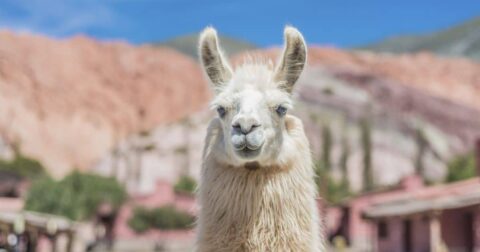Explainer
How Overconsumption Affects the Environment and Health, Explained
Climate•12 min read
Reported
A family in Guatemala chose to keep llamas rather than sell them for meat. Two decades later, they teach tourists how to be more sustainable.


Words by Isabella Rolz
The highest mountain range in Guatemala is known for its uniquely cold and humid temperatures. La Sierra de los Cuchumatanes is unlike the rest of the country — a difficult region to farm. But it’s also one of the most biodiverse spots in the country, and where llamas, who thrive in a cold climate, can be found.
More than two decades ago, the residents of Todo Santos, a small town in Chiabal, Huehuetenango, came up with the idea of importing llamas from Chile. The cool temperatures of their village were closer to the Andean Mountain Range in South America rather than the rest of Guatemala. In Latin America, llamas are found in Bolivia, Peru, Ecuador and Chile — they need low temperatures to survive.
The residents brought 32 llamas from Chile to use as a means of transportation, to produce wool and sell their meat. The animals were distributed among different families of Todo Santos; to use however they saw fit. Marcos Cruz, 46, and his family received four of the llamas. A long-time animal lover, Cruz could not bear the thought of using the animals for any of these purposes — each struck him as exploitation. As a practitioner of the Mayan culture, Mam, “protecting and caring for animals is a priority for me and my family,” he explains in Spanish.
Cruz learned how to care for the llamas instead, and since he had experience with other animals, like sheep and horses, he realized what kind of maintenance they required to survive. “It was a challenge at first because coming from another country, for example, the grass they ate was not the same we have here, and we did not know when they were sick and how to react to their illnesses,” says Cruz.
Along with his family, he came up with an innovative idea: show tourists who visited Huehuetenango that llamas can live safely and unharmed in this area of Guatemala. It took several years for Cruz to transform his ranch into a tourist site where visitors can observe and learn about the animals. “Now, we show both locals and foreigners how we care for them, what they eat, how they are treated daily and most importantly, we let them interact with them. After all, they are animals only found in this part of the country, making their visit unique,” he says.
Cruz and his family currently have 13 adult llamas and three newborns. “We are proud to know how to reproduce and not misuse them. The other families that received the llamas abused and mistreated them, and this was miserable to witness,” Cruz says.
Huehuetenango is a region that, due to its cultural richness and Mayan legacy, is seen as significant by the Guatemalan Institute of Tourism, especially the way residents protect the environment, including the animals who live in its ecosystem. “Within our framework, our number one project is to promote sustainable tourism in Huehuetenango,” and this has everything to do with climate change, says Edy Chicas, Delegate of Huehuetenango for the Guatemalan Institute of Tourism.
Chicas works with the villagers, a very close-knit community, on a wide range of environmental issues, including dealing with waste, climate change and sustainable tourism. So far this year, the Guatemalan Institute of Tourism has given around fifteen talks to each village. “Our goal is to make sure that this tourist culture, composed of both the visitor and the person who receives the tourist, interacts with one another in the best possible way. By this, I mean that both parties are aware of the importance of keeping the tourist sites impeccable, so that their beauty is shown and its environment is maintained in excellent condition,” says Chicas.
There are programs aimed at forest governance, for instance. Some villagers have been reportedly cutting off the tree bark, which can be damaging not only to the tree, but the entire ecosystem. Through the training, villagers learn how essential it is to prevent this kind of damage, as well as other types of illegal logging, with sustainable forest management strategies. “This is a way to reduce climate change through the preservation of forests,” says Chicas.
Another example is a project used by the Cruz family to keep the village free from garbage. The characteristics that make plastic a durable material for humans also make it a danger to animals when left uncollected. “In some cases, we see farm animals try to eat the plastic,” says Cruz. “We visit the sites and do cleanup days where we bring rakes, brooms and garbage bags to clean the areas and teach villagers the importance of keeping these places intact,” says Chicas.
The villagers in turn teach tourists how to do their part to minimize their environmental impact. Community members make signs that say, “No littering, please. Leave it with your belongings.” During these campaigns, villagers collect large amounts of solid waste, separate and transport the waste to a treatment plant for final disposal. According to residents, the quantity of abandoned garbage has since decreased.
Maintaining the farm is of paramount importance to Cruz and his family, and Chicas sees this as a powerful form of . “Because tourists find it wonderful and desire to come back, we want to replicate this in all the tourist communities of Huehuetenango.” Chicas adds that for him, sustainable tourism creates what he refers to as responsible tourism, where a link is established between the visitor and the receiver, and where both are conscious of protecting the environment.
Cruz and his son have also learned to use different social media platforms such as Instagram, Facebook and Tik Tok to launch the Llamas de los Cuchumatanes Project, which shows how they give care to the llamas, and how they work to protect their surrounding environment.
“We like to show how this is a community initiative and a family project. We also want our audience to know that the llamas are well-maintained and that we keep the farm clean,” Cruz says. He explains that he wishes to encourage other families in his community who own llamas to care for them similarly, and avoid misusing them.
“The llamas are one of the main attractions of the La Sierra de los Cuchumatanes,” says Chicas. The Cruz family has been able to make the most of hosting the animals while treating them well. “The goal is to replicate their tourism strategy with other families from the village.”
“We are humble people with scarce resources who come from a tough socio-economic background. However, this does not stop us from protecting our land, animals and culture,” says Cruz. “We are family people and we like to interact as a community. For us it’s like having a child, a family member.”
This piece has been updated.